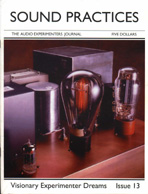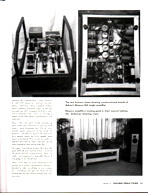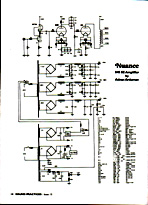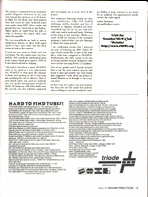

This article appeared in SOUND PRACTICES magazine issue 13 (written on February 1997) "What would you like to achieve in life?" was an out of the blue question my wife asked me two years ago. How should a Turkish citizen, living in Istanbul, 43 years old (41 at that time), mechanical engineer, representing and distributing Carrier Air Conditioning equipment in Turkey for many years, an Audiophile tube and Music lover and the president (this year) of Istanbul Hi Fi Club reply this question? Although not very uncommon, the question struck me as if I was hearing it for the first time - maybe I was hearing it for the first time!
"I want to design and build my own tube amplifier" was my reply, "but unfortunately I have to wait my retirement". She suggested that I should consider starting it at that very moment (she is a therapist!!). Her following arguments were convincing enough and the idea so attractive: I agreed.
First I contacted my electronic guru friend (who builds his own marble speakers) and asked him if he would volunteer to teach me just enough electronics to achieve my project. He gladly accepted, gave me several books and suggested I subscribe to both Glass Audio and Sound Practices [...but not necessarily in that order -ed.] and buy all past issues, which I did. After much reading, lessons from my friend, my realization of the analogy between tube curves/load lines and pump curves/system curves I'm used to working with in my job, the inner workings of amplifiers eventually began to make sense to me.
Thanks to the great influence of SP magazine I've decided to build a single ended amp (the concept of SE or PP was totally new to me). For a beginner SE amps were easier to understand and to conceive, apparently had a magical mid-range, were unheard of here in Turkey, in other words it was a "Mystery Cafe". My intuition (which played a major role throughout the project) also said: SE.
The whole point of the project was to improve on the sound of my existing push-pull ARC Classic 60 amp; here again my intuition said that only a "cost-no-object" SE amp would be able to achieve this goal. It had to be as purist as possible (no parallel tubes) and capable of driving a relatively wide range of speakers.
I chose to build a single 845 tube, driven by 300B with a SRPP configured 6072A at the front end. Separate power supply circuits for each tube and mono design would be adopted. Gordon Rankin's article (A Single "807" Amplifier, issue #2) was a great help for starting my calculation and design.
After finishing my preliminary calculations and circuit schematic, I contacted Allen Wright (author of the The Tube Preamp Cookbook) for consultancy. He suggested me to use "choke input" filters instead of the originally drawn capacitor input ones. "As you aim a cost-no-object amp you should have the best filtration, and choke inputs will give you a much better result if you have space and money to spend. Thus, you may as well use solid state diodes as their switching noise will be filtered by the chokes. It is also the solution adopted by Cello" was his argument to defend the choke input.
He suggested to split the first choke to two and place one to positive and one to negative leg after the bridge in order to filter the whole of the mains trash. Verifying what he had mentioned with the Radiotron Designers Handbook and cross checking it with my guru friend, I applied his suggestion to the point and used three chokes per tube (in total 9 chokes per side!).
The same purist philosophy and intuition was in use when it came to selecting and ordering the components: I used TANGO X-10S OPT (best of TANGO for 845 tubes), Gold Aero tubes, Caddock, Vishay, Holco resistors, Hovland Caps on the signal path and MIT bypassed SOLEN's elsewhere, Kimber AG cable on all signal paths, SOWTER mains transformers and inductors.
Since I had very good results (picking up more detail and extention on the top end) when I tried bypassing the 250 uF electrolytic input capacitor of my Quad 63 speakers, I decided to bypass all capacitors. As a unique touch, an LCD display hour meter is included. This would be useful to indicate the burn-in times and give me an exact statistical idea about tube life.
On paper everything looked fine but the most difficult part started when I received all these HUGE components. How on earth I was supposed to assemble them? It was going to be monstrous!
After a few days of acute depression followed by a heavy meditation period I decided to take everything to our company's workshop and get the help of our technicians for the chassis design and construction.
The chassis is constructed from aluminum profile. Magnetic elements on my amp were banned like smokers in a US domestic flight. For the finish only black painted brass and wood are used. Soldered joints were made using WBT Silver solder and ground lines are connected in star fashion. Signal inputs are made from the sides in order to shorten the signal cable runs inside the amplifier.
The two mono blocks are built in mirror symmetrical fashion to allow both signal inputs to face each other and the hour meters to look to the exterior.
It took me two years to finish and test everything. The test results came out wonderfully with a perfectly symmetrical sinus at the output which gives approx. 25W on 8 ohm fixed load before clipping.
I had also to find them a name. NUANCE came to my mind as a very appropriate one: NUANCE is what gives the emotion to Music and meaning to life. It was lucky and surprising for me to discover that no such brand name was used by anybody else. Its model designation would be Op.65, 65 being my wife Eda's birth year. She was the one who initiated, supported and encouraged me at every level of the project.
The subjective listening results are also very satisfactory: silky, full bodied midrange, trebles detailed and free of harshness or edginess, extended and fairly controlled bass (if not on par with best solid state and/or push-pull gear). Nothing seems tiring at any duration. Maybe as a result of this (or because of the increased pleasure) I noticed that I am now listening to Music for longer periods.
I can confortably declare that I achieved my goal of bettering my ARC Classic 60 amp which sounds thin or lean in the mids like a solid state compared to NUANCE. Furthermore, the ARC seems to be less involving and less musical. Subjective tests are carried out using ProAc 2.5 speakers.
One of my "golden eared" friend declared that it was the most musical amp he had heard to date and another one (who builds kits) suggested I write about my project in Sound Practices as he thought it was a success story.
So here I am. Its a pity I can only transmit the story but not the sound but anybody who is willing to visit my wonderful country, Turkey, is most welcome to my home for an audition. For appointments kindly contact the undersigned.
Adnan Arduman



